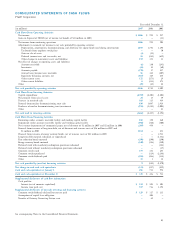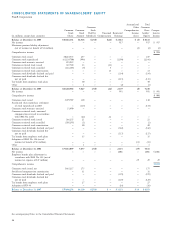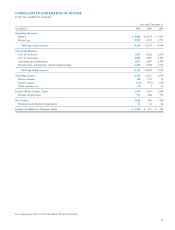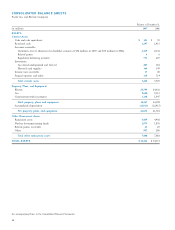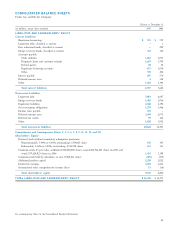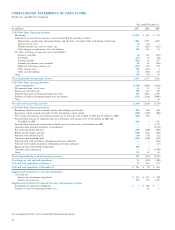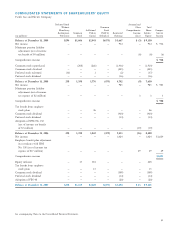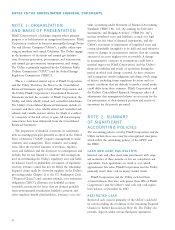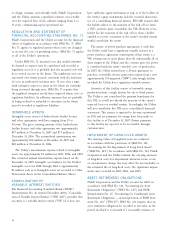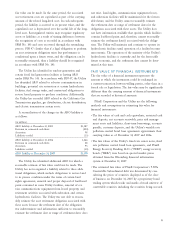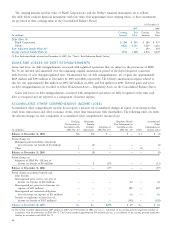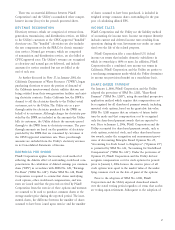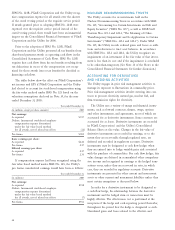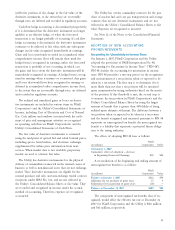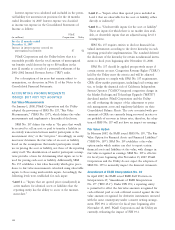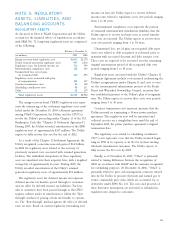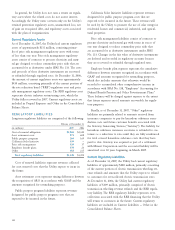PG&E 2007 Annual Report Download - page 97
Download and view the complete annual report
Please find page 97 of the 2007 PG&E annual report below. You can navigate through the pages in the report by either clicking on the pages listed below, or by using the keyword search tool below to find specific information within the annual report.
95
fair value can be made. In the same period, the associated
asset retirement costs are capitalized as part of the carrying
amount of the related long-lived asset. In each subsequent
period, the liability is accreted to its present value, and the
capitalized cost is depreciated over the useful life of the long-
lived asset. Rate-regulated entities may recognize regulatory
assets or liabilities as a result of timing differences between
the recognition of costs as recorded in accordance with
SFAS No. 143 and costs recovered through the ratemaking
process. FIN 47 clarifi es that if a legal obligation to perform
an asset retirement obligation exists but performance is
conditional upon a future event, and the obligation can be
reasonably estimated, then a liability should be recognized
in accordance with SFAS No. 143.
The Utility has identifi ed its nuclear generation and
certain fossil fuel generation facilities as having ARO
under SFAS No. 143. In accordance with FIN 47, the Utility
has identifi ed ARO related to asbestos contamination in
buildings, potential site restoration at certain hydroelectric
facilities, fuel storage tanks, and contractual obligations to
restore leased property to pre-lease condition. Additionally,
the Utility has recorded ARO related to the California Gas
Transmission pipeline, gas distribution, electric distribution,
and electric transmission system assets.
A reconciliation of the changes in the ARO liability is
as follows:
(in millions)
ARO liability at December 31, 2005 $1,587
Revision in estimated cash fl ows (204)
Accretion 98
Liabilities settled (15)
ARO liability at December 31, 2006 1,466
Revision in estimated cash fl ows 48
Accretion 95
Liabilities settled (30)
ARO liability at December 31, 2007 $1,579
The Utility has identifi ed additional ARO for which a
reasonable estimate of fair value could not be made. The
Utility has not recognized a liability related to these addi-
tional obligations, which include obligations to restore land
to its pre-use condition under the terms of certain land
rights agreements, removal and proper disposal of lead-based
paint contained in some Utility facilities, removal of cer-
tain communications equipment from leased property, and
retirement activities associated with substation and certain
hydroelectric facilities. The Utility was not able to reason-
ably estimate the asset retirement obligation associated with
these assets because the settlement date of the obligation
was indeterminate and information suffi cient to reasonably
estimate the settlement date or range of settlement dates does
not exist. Land rights, communication equipment leases,
and substation facilities will be maintained for the foresee-
able future, and the Utility cannot reasonably estimate
the settlement date or range of settlement dates for the
obligations associated with these assets. The Utility does
not have information available that specifi es which facilities
contain lead-based paint and, therefore, cannot reasonably
estimate the settlement date(s) associated with the obliga-
tion. The Utility will maintain and continue to operate its
hydroelectric facilities until operation of a facility becomes
uneconomic. The operation of the majority of the Utility’s
hydroelectric facilities is currently and for the foreseeable
future economic, and the settlement date cannot be deter-
mined at this time.
FAIR VALUE OF FINANCIAL INSTRUMENTS
The fair value of a fi nancial instrument represents the
amount at which the instrument could be exchanged in
a current transaction between willing parties, other than in a
forced sale or liquidation. The fair value may be signifi cantly
different than the carrying amount of fi nancial instruments
that are recorded at historical amounts.
PG&E Corporation and the Utility use the following
methods and assumptions in estimating fair value for
fi nancial instruments:
• The fair values of cash and cash equivalents, restricted cash
and deposits, net accounts receivable, price risk manage-
ment assets and liabilities, short-term borrowings, accounts
payable, customer deposits, and the Utility’s variable rate
pollution control bond loan agreements approximate their
carrying values as of December 31, 2007 and 2006.
• The fair values of the Utility’s fi xed rate senior notes, fi xed
rate pollution control bond loan agreements, and PG&E
Energy Recovery Funding LLC’s (“PERF”) energy recovery
bonds (“ERBs”) were based on quoted market prices
obtained from the Bloomberg fi nancial information
system at December 31, 2007.
• The estimated fair value of PG&E Corporation’s 9.50%
Convertible Subordinated debt was determined by con-
sidering the prices of securities displayed as of the close
of business on December 31, 2007 by a proprietary bond
trading system which tracks and marks a broad universe of
convertible securities including the securities being assessed.


